Kemptville began on Clothier Street East. It was along this street that the early village developed, where hotels and service industries such as blacksmiths, general stores and the post office were located. The street parallels the river, the focus and reason for the village from the beginning in the 1820’s. This is the land that Lyman Clothier bought in order to build a saw mill in the 1820’s, and it remained the main street of Kemptville until after the fire of 1872, which destroyed much of Prescott Street. When it was rebuilt, the focus of the village shifted across the river. But Clothier Street east continued to be an important thoroughfare, the site of many important businesses in the commercial life of the village.
Clothier Street East Historical Walking Tour
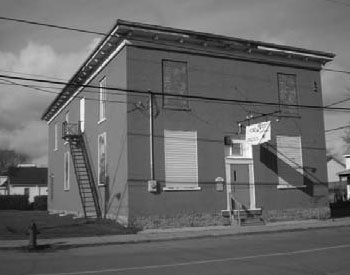
Built in 1859 by Joseph Bower, a leading merchant in the community in the latter half of the century, it was run by Bowers and his sons as a general store until 1870. In 1888, an Agricultural Fair was being held here, and it became the first building in Kemptville to be lit by electric lights, as lines were run especially for the occasion from George Keating’s mill above the bridge at Prescott Street. It was bought by the Independent Order of Odd Fellows in 1892, two years after they had arrived in Kemptville. The store was remodeled with lodge rooms on the second floor, and an Opera House on the ground floor. This hall has been used by the community ever since for public and private events, annual Fireman’s Balls each March 17th, and regular dances, plays and concerts. For a few years in the 1940's it was used as a movie theatre.
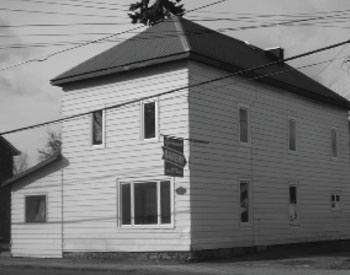
This site was the lo- cation of a home built by Asa Clothier in the 1820's. Thomas Hicks erected this building and sold it to Alphaeus Patter- son in 1885. Patter- son opened a bakery here, and it has re- mained a bakery ever since. It still uses the same wood-fired brick oven installed by Patterson. The bakery was owned and run by A. Eager until 1922, when he sold it to Bert Frisby, who taught the trade to Leonard Grahame who in turn bought out Frisby when he retired. The bakery has remained in the family ever since, and has been recognized by the Heritage Canada Foundation.
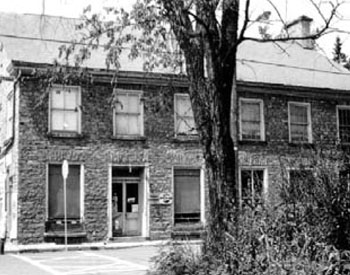
This building has been a centre of activity in Kemptville since 1847, when it was built by Fran- cis Jones, an Irishman who taught school in Oxford for many years. In 1840, he became a licenced Land Surveyor, a job he maintained while operating a store out of this building. He was Member of Parliament for the area from 1862 until 1874. The store was operated from 1855 by Joseph Leeming, and has been the location of general stores, furniture stores and undertakers under various tenants since it was built. The building was also the loca- tion of Kemptville’s very first newspaper. Between 1855 and 1860, R. W. Kelly published the Progressionist here, a fervently Tory paper. The printing machines for the newspaper were brought to Kemptville on the first train to arrive in town, in 1854. Max Miller bought the building in 1942 and ran a store for many years. A white frame addition served as the Beth Israel Synagogue for the local Jewish community before it was closed and demolished in 1985.
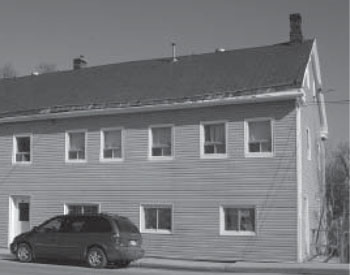
This large frame building has been standing since at least the 1860's and has been used for many businesses over the years. It was the location of William R. Anderson’s Tailor shop, a fashionable business which he ran until his death in 1875. He lived above the shop, and shared the building with Thomas Cosgrove’s Furniture and Undertaking establishment, for more than 25 years the only such business in Kemptville. The business grew over the years and eventually moved across the river to the Hinton Block. At the back was a Picture Framing shop and John Curry ran a grocery store too. When it was advertised for sale in 1899, it contained eleven rooms, halls and a fire-proof vault. It stood on the corner of Clothier and Fanny Streets, the latter an unopened road used by generations of children for a toboggan slide.
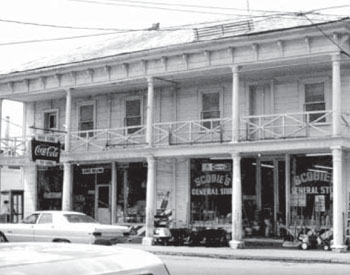
A parking lot is all that is left of what was once a social and commercial centre for Kemptville. Residents today remember Scobie’s Store and the billiard hall. But the original building dated from 1832, when it was erected by Mahlon Beach as a hotel, which he ran for a number of years before selling it to Thomas Beckett. Beckett’s Hotel was where Squire Bottum held court sessions in the 1830's. In the 1840's, Beckett sold the hotel to William Mc- Gregor, who replaced the older building and contin- ued to operate the hotel, now called the “American House Hotel”, until 1880, when he converted it to use as a store. The stables for the hotel were located behind the building. The store was a large and important one, selling everything from farm tools and seeds to tea and furs. The hotel stables were converted to store houses. In the late 1960's, it was divided into a store and a billiard hall. The building was destroyed by fire in 1991.

Where there is now a ong, low building, there once existed a large, two-story building that served as both a store and a hotel for many years in the life of the community. In 1838, it wasastorerunbya man called White, and a gathering place for people eager to hear news of the Battle of the Windmill in Prescott. Around 1842, it was bought by Alexander Beckett who opened one of the first hotels in the town. It passed through three owners, including William Johnston, who called it the “King William II Hotel”. Robert Kerr bought it in 1866 and it remained in his family until 1899. It was heated by hot air, lit by electricity and comfortably furnished. As late as the 1930's, it was a rooming house hotel operated by Dan O’Neill with stables still existing behind the building and a covered passage leading from them to Clothier Street. In the 1950's, it was bought by the Swedlove family, who added it to their premises next door and ran a furniture store from it. It later became the Canadian Tire Store before that company moved to Highway 43.
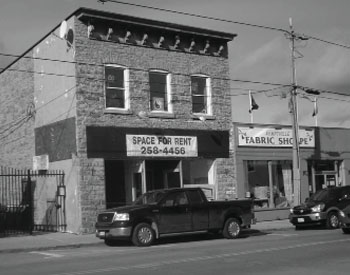
There were a number of businesses on the site until, in 1872, John Wolfe sold 800 square feet of the land to Robert Kerr on condition that only a stone or brick building be erected. This is the building that stands today. Around 1912, Lodge No. 334 of the Orange Order moved into the upper floor of the premises, which was then the location of Johnston’s Furniture and Undertaking business. In 1922, the building was bought by the United Farmers of Ontario, and the Orange Order moved to the Fraser Block. The UFO, in turn, sold to the Swedlove family in 1933 who opened a grocery and dry goods store. The property was added to the land on the east side (Kerr House) in 1937 and a large furniture store was added to the operation.
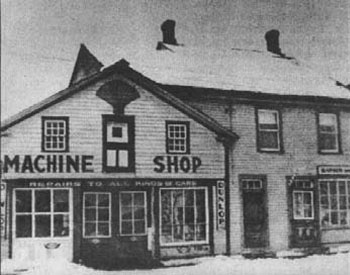
This was the site of the very first store in Kemp- tville. Levius Church opened his store here at the end of the 1820's and operated it for several years. It was a branch of his main business in Prescott. It was recorded that “The farmers usually paid their store bills in ashes, collected when clearing the land, which the merchants made into potash, and with that paid for their goods”. The first Post Office in Kemptville operated out of Church’s store. There have been a number of businesses on the site, including a machine shop, the first garage in town, run by Del Seymour, and a Salvation Army Thrift Store. An attached building, now the pub patio, housed a series of barber shops over the years. Recently, the premises were extensively renovated, maintaining a traditional shopfront appearance.
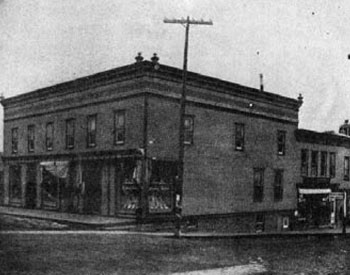
The Rotary Park site was once a major centre of commerce in Kemptville. Levius Church operated a potash plant on the river here in the 1830's. The property was taken over in the 1850's by Thomas Maley, a successful fi- nancier and entrepreneur. Over the years the Maley Block was enlarged into a three-story edifice covering the entire block from the bridge to Clothier Street, with offices and stores facing on to both streets. The Block contained many enterprises over its history, including a job printing office, tailors, lodge rooms for the Orange Order, watch makers and jewelers, and the Public Library. In 1922, a fire broke out in a butcher shop in the basement and the entire wood frame structure was quickly reduced to ashes. It was never rebuilt. A gas station stood on the site from 1927 until 1974.
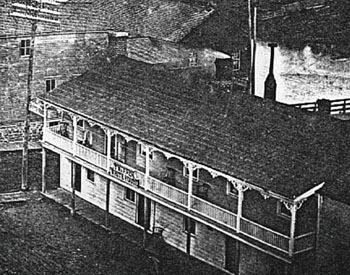
The White House Hotel was built by Nathaniel Fenton in the late 1830's, and it became a popular stop for visiting businessmen. It was located convenient to the two mills operating on the river behind it. Thomas Adams bought the hotel in 1865.Thomas Warren owned it from 1894 until 1928, when it was torn down and replaced by a service station. One of the first buildings in town to be heated by furnace and lit by electricity, it also had large carriage and livery barns in the rear, with power generated by two windmills, a very luxurious asset for the horse age. This establish- ment took up the entire block from Clothier Street to the river, and was one of five hotels along this stretch of Clothier Street East.
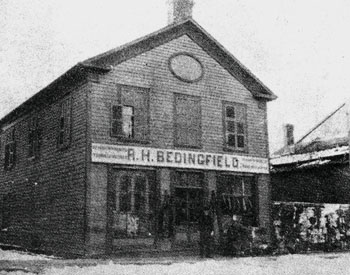
In 1870, Robert H. Beddingfield bought a piece of land front- ing on Clothier Street and opened a har- ness salesroom and workshop. In 1882, he expanded his property in the rear back to Oxford Street and carried on sell- ing saddlery, trunks, valises and other leather goods. After his death in 1912, the property changed hands numerous times, bringing various businesses to the site. Creswell Johnson had a machine shop and Garnet Van Allan ran the Dodge dealership and sold radios and washing machines. Kemptville Mo- tor Sales sold to the Swedloves in 1959, and it became part of that family’s holdings along Clothier Street. It has been a restaurant for a number of years, having being added to on the east side.
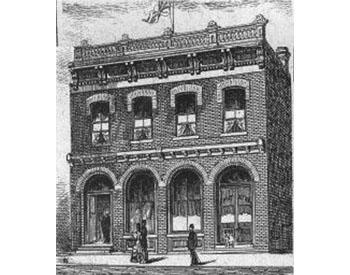
Asa Clothier built a black- smith shop on this site in 1816, before selling the property in 1826. It came into the hands of the Leslie family in 1837 and by 1862 Robert Leslie had erected the imposing building pictured here. It became Kemptville’s Post Office, with Robert Leslie as Post Master. The Ad- vance newspaper started here in 1888. A serious fire in the print shop in 1909 caused severe damage to the building, and shortly thereafter the Post Office and newspaper moved to new locations on Prescott Street. In 1943, Leabourne Elliott bought the building and, as the first IGA store, brought super- markets to Kemptville. It was later taken over by the CIBC bank, and then served as a pizzeria before being demolished in the 1990's.
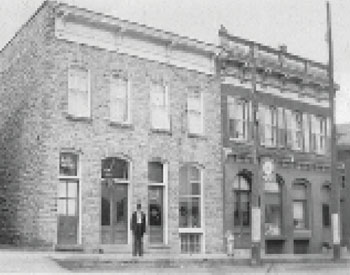
Thomas Hicks erected this build- ing around 1880 who operated a grocery store and lived above the shop. He sold it to Alphaeus Pat- terson in 1890. Patterson was a baker who later moved to what is today Grahame’s Bakery. It then became a fur- niture store, with offices upstairs. The future Premier of Ontario, G. Howard Ferguson, had his law offices upstairs in No. 13, and he was followed by the firm of Boucher & Loucks, solicitors to the Corporation of Kemptville. J. G. Pelton bought the building in 1899 and moved the telephone exchange there, where it remained for more than fifty years. In 1923, the Orange Order bought the building and had their lodge rooms upstairs, renting the ground floor and basement to Bell. The Order sold the premises in 1984, since then it has operated primarily as a restaurant. The original tin ceiling on the first floor won the building a Heritage designation in 2008.
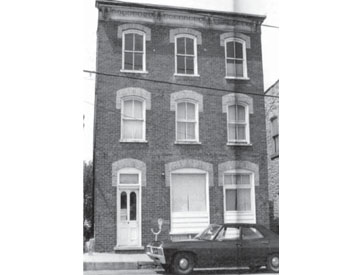
Robert Craig bought this prop- erty in 1878 and he erected this building as a residence and shoe and shoe repair shop. He stocked both pre-made shoes and made-to-order, and trained generations of shoemakers in Kemptville. When he died in 1899, the building was sold to the O’Neill family and became one of the smartest hat shops in town, run by Misses Anna and Julia O’Neill. Their clien- tele expected sophisticated and creative millinery, and all were unique works for just $10 each. After almost thirty years, the store changed hands and became Ross’ Grocery and Candy Store. It has remained a store for most of the years since, although the exterior has been altered radically over time, as the picture illustrates.
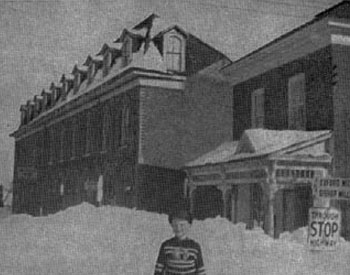
The site of Asa Clothier’s original saw mill, around which Kemptville developed, was located directly behind this building on the river bank. In 1877, Ambrose Clothier erected a three-storey building which was laid out for stores, offices and dwellings. Different co- loured bricks were used in the construction to give an attractive design to the frontage. It took some time for the building to become a profitable investment, but it then became an important commercial centre until 1955. The Clothier family sold the building in 1904, after which it was known as the Bailey Block. After 1946 it was known as the Finnerty Block. In 1955, four people were killed in a major fire which destroyed the top two floors of the building. A later fire caused major changes in the structure. The Swedlove family bought it in 1956, and sold it to Kemptville Weekly Lodging Ltd. in 1988. It has operated as a hotel since then.
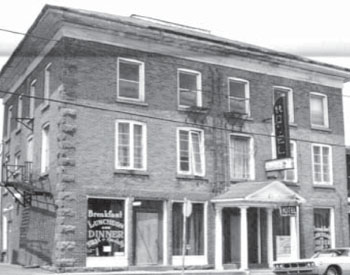
Lyman Clothier built a house on this site around 1820, and it was moved to where it now stands at the corner of Rideau and Oxford Street. This was one of only two residences in Kemp- tville at the time. His son, Ambrose Clothier built the present edifice as his family home around 1861, from bricks made from clay taken from the river bank, where his family owned a brick yard. Originally, a cupola topped the building, which was transformed into a feed store and home by Henry Dell after 1868. Dell ran a liquor store, and the Orange Lodge occupied the third floor after 1880, accessed by outside stairs. A feed warehouse extended along the rear where there is a parking lot now. This store was taken over and operated by Joel Anderson between 1912 and 1940, although the building was actually owned by James Fairbairn. He, in turn, sold it to Charles Graham who turned it into a hotel in 1940, and it remained as such through subsequent owners until the late 1990's.

